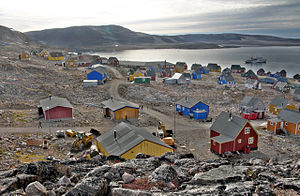Ittoqqortoormiit
Ittoqqortoormiit
Scoresbysund | |
|---|---|
Town | |
 | |
| Country | Kingdom of Denmark |
| Province | |
| Municipality | Sermersooq |
| Founded | 1925 |
| Area | |
| • Total | 235,000 km2 (91,000 sq mi) |
| Population (2005) | |
| • Total | 537 |
| Time zone | UTC-1 (UTC-1) |
| Website | http://www.ittoqqortoormiit.gl/ |
Ittoqqortoormiit (Inuit pronunciation: [itoqɔʁtɔʁmit], Template:Lang-da) is a town in the Sermersooq municipality in eastern Greenland, located at approximately 70°31′N 22°00′W / 70.517°N 22.000°W near the mouth of the northern shore of the Kangertittivaq fjord. Population is 537 (as of 2005). The Danish name Scoresbysund derives from the name of the Arctic explorer and whaler William Scoresby, who was the first to map the area in 1822. The Greenlandic name Ittoqqortoormiit means "Big House". The region is known for its wildlife which includes polar bears, muskoxen, and seals.
History
Ittoqqortoormiit was founded in 1925 by Ejnar Mikkelsen and some 70 Inuit settlers on the ship Gustav Holm, 400 km south of the last Inuit settlement in Northeast Greenland (Eskimonæs at Dødemandsbugten on the south coast of Clavering Ø, 27 km southwest of later Daneborg, 1823).
The settlement was encouraged by the colonial power Norway which at the time had a growing interest in Northeast Greenland. At the same time, the colonization was intended to improve declining living conditions in Tasiilaq, from where the settlers were more or less voluntarily transferred. The settlers soon prospered on the good hunting conditions of the new area, which was rich in seals, walruses, narwhals, polar bears and arctic foxes.
Before that, however, the area itself had been home to a dense population of Inuit in the past, as testified by ruins and other archeological remains.
Transport
Ittoqqortoormiit is one of the most remote towns in Greenland. It is served by the Nerlerit Inaat Airport, reachable by helicopter or boat for a few months a year. There are two Air Iceland weekly departures from Reykjavík, synchronized with flights to Kulusuk in southeastern Greenland. Air Greenland provides indirect air communication with the rest of the country from Kulusuk.
Economy
Local hunters have for generations made a living from whale and polar bear hunting, and it remains, up to the present, a significant cultural-economical factor in the area. Flesh and by-products play a direct part in the economy of the hunting families. Income is gained by trading these products, but these options are seasonal and variable. Ittoqqortoormiit lies near large populations of shrimp and Greenland halibut, but the presence of sea ice prevents the exploitation of these resources year-round, and as a result fishing has never been extensively developed in the municipality. Tourism, on the other hand, is growing in importance.
Gallery
-
Inside Ittoqqortoormiit church
-
Bust of Danish Explorer Ejnar Mikkelsen
-
Ittoqqortoormiit houses
-
Kangertittivaq shore
References
- Greenland and the Arctic. By Etain O'Carroll and Mark Elliott. Lonely Planet 2005. ISBN 1-74059-095-3.
- Greenland in Figures 2005 Statistics Greenland. 3rd Edition, May 2005. ISSN 1604-7397
- ittoqqortoormiit.gl



